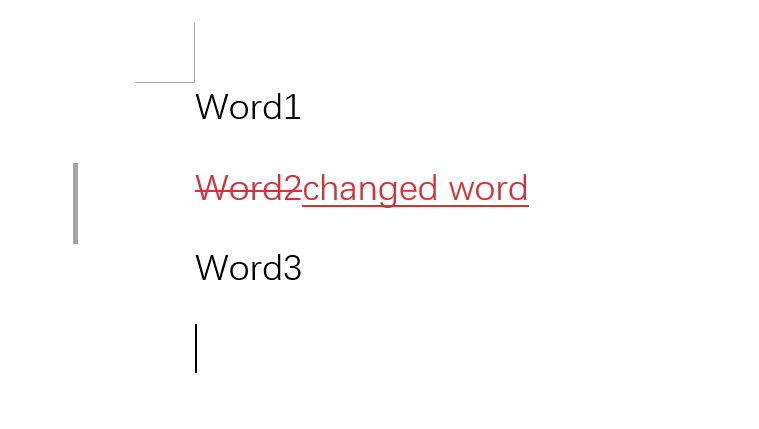Inspired by https://github.com/python-openxml/python-docx/issues/566
Python docx
Python docx is a library that allows you to read and do limited control to doc file.By simply call 'doc', you can convert word file into Document class, which will allow you to get paragraphs and tables.
The very basic element defined in docx is run, which is the basic text container in both table and paragraphs. For example, the code below prints all run and you can figure out the structure here:
import docx
INPUT_FILEPATH = 'file.docx'
doc = docx.Document(INPUT_FILEPATH)
print([[run.text for run in p.runs] for p in doc.paragraphs])
#>>[['W', 'ord', '1'], [], ['Word3'], []]
You may find that run is a compress unite that may contain a part of a single word, a single word or several words. And some run elements seems to have no content here.
TL;DR: Control everything although docx does not support this
docx library will only select tags it know (w:p, w:b, w:r, etc.) and will ignore tags it doesn't know (w:ins, w:del, etc.)
The basic idea of docx is to implement a series 'proxy class' to represent the
<w:p><w:r>etc. , and you can callelementproperty to bypass the proxy class to get the actual object, which is a subclass of _ElementWhen you do this, you can use methods from
_Elementto do xml operation includinggetnext,getparent,addnextetc.You can also build a
_Elementof your own from string and insert it to certain position located by docx:def return_a_w_ins_element(): xml = ''' <w:ins xmlns:w="http://schemas.openxmlformats.org/wordprocessingml/2006/main" w:author="Leroy Jim" w:date="2018-10-10T14:12:00Z" w:id="1480"> <w:r w:rsidR="00464094"> <w:t> AND ANOTHER CHANGE</w:t> </w:r> </w:ins> ''' tree = etree.fromstring(xml, parser=etree.XMLParser(ns_clean=True)) tree = etree.ElementTree(tree) return tree.getroot()Since there is no 'revision' classes in docx but you can build a
<w:ins>, convert it into element, and insert it to any proxied element, if you follow rule of ms word.
Proxy Pattern of docx
Because docx has tried to use Proxy Pattern to do wrapper xml nodes behind into classes like run and paragraph. If we look into the source code, the proxy class of run is :
class Run(Parented):
"""
Proxy object wrapping ``<w:r>`` element. Several of the properties on Run
take a tri-state value, |True|, |False|, or |None|. |True| and |False|
correspond to on and off respectively. |None| indicates the property is
not specified directly on the run and its effective value is taken from
the style hierarchy.
"""
def __init__(self, r, parent):
super(Run, self).__init__(parent)
self._r = self._element = self.element = r
Notice that self._r = self._element = self.element = r will pass value to the real class that wrapping <w:r>
class CT_R(BaseOxmlElement):
"""
``<w:r>`` element, containing the properties and text for a run.
"""
rPr = ZeroOrOne('w:rPr')
t = ZeroOrMore('w:t')
br = ZeroOrMore('w:br')
cr = ZeroOrMore('w:cr')
tab = ZeroOrMore('w:tab')
drawing = ZeroOrMore('w:drawing')
In another word, the docx will wrapper some tabs(just like these tags below) into identified class, therefore, if we try to print the type of run :
doc.paragraphs[0].runs[0]
#>><docx.text.run.Run at 0x248dd5bde80>
while the actual class behind the proxy can be cited by calling element since python will not prevent access to variable inside class:
doc.paragraphs[0].runs[0].element
#>><CT_R '<w:r>' at 0x248dd939310>
If you check the type of this object, you can find that it is the CT_R below:
type(doc.paragraphs[0].runs[0].element)
#>>docx.oxml.text.run.CT_R
Why We Need to Bypass the Proxy Pattern
If you take a look at the implementation of CT_R, you will find that it is a subclass of BaseOxmlElement, and let's take a look the implementation of this class:
BaseOxmlElement = MetaOxmlElement(
'BaseOxmlElement', (etree.ElementBase,), dict(_OxmlElementBase.__dict__)
)
When you import BaseOxmlElement from docx, the actual class is defined in _OxmlElementBase which is a subclass of etree.ElementBase
class _OxmlElementBase(etree.ElementBase):
"""
Effective base class for all custom element classes, to add standardized
behavior to all classes in one place. Actual inheritance is from
BaseOxmlElement below, needed to manage Python 2-3 metaclass declaration
compatibility.
"""
__metaclass__ = MetaOxmlElement
This helps explain why we can use API from https://lxml.de/api/lxml.etree._Element-class.html after getting element.
Take a Closer Look
Docx actually will ignore elements it does not know, for example, if we have a word:

The xml structure under <w:d> or <w:body> should be :
<w:p>
some <w:r>
<w:del>
<w:ins>
some <w:r>
<w:p>
We can do some code to figure it out:
doc = docx.Document(INPUT_FILEPATH)
[[run.text for run in p.runs] for p in doc.paragraphs]
#>>[['W', 'ord', '1'], [], ['Word3'], []]
You will notice that only <w:r> is got. The first paragraph has 3 runs, the second one has none, and the last one has 1 run.
But, why is our ins and del nodes gone? We can call '_element' to bypass the proxy and use 'getchildren()' to get nodes, for example, we can get 3 runs from the first paragraph:
doc._element.getchildren()[0].getchildren()[0].getchildren()
#>>[<CT_R '<w:r>' at 0x1e9c95a7090>,
#>> <CT_R '<w:r>' at 0x1e9cb3f4130>,
#>> <CT_R '<w:r>' at 0x1e9cb3f4090>]
Notice that the docx actually still identified them because there is a 'xml element'->'CT_R'->'Run' transfer.
And when getting children nodes from second 'Blank' paragraph:
doc._element.getchildren()[0].getchildren()[1].getchildren()
#>>[<Element {http://schemas.openxmlformats.org/wordprocessingml/2006/main}del at 0x248dd5c0bc0>,
#>> <Element {http://schemas.openxmlformats.org/wordprocessingml/2006/main}ins at 0x248dd682bc0>]
You will notice that these are elements that is not recognized by docx, but you can still get them, and in this situation the class will be Element, which is the ins, and del nodes in the word.